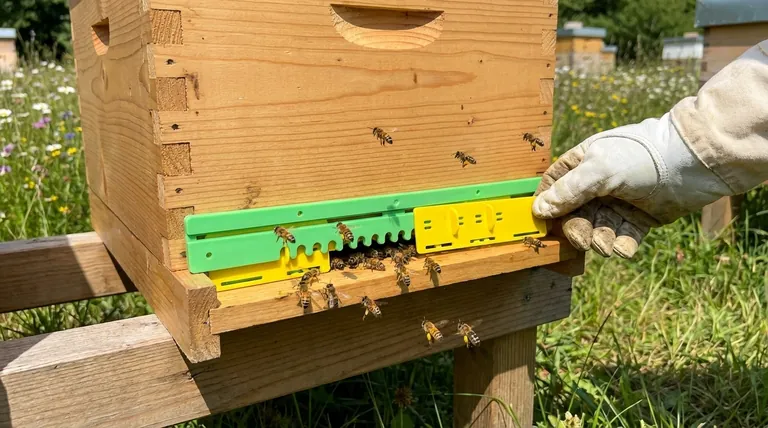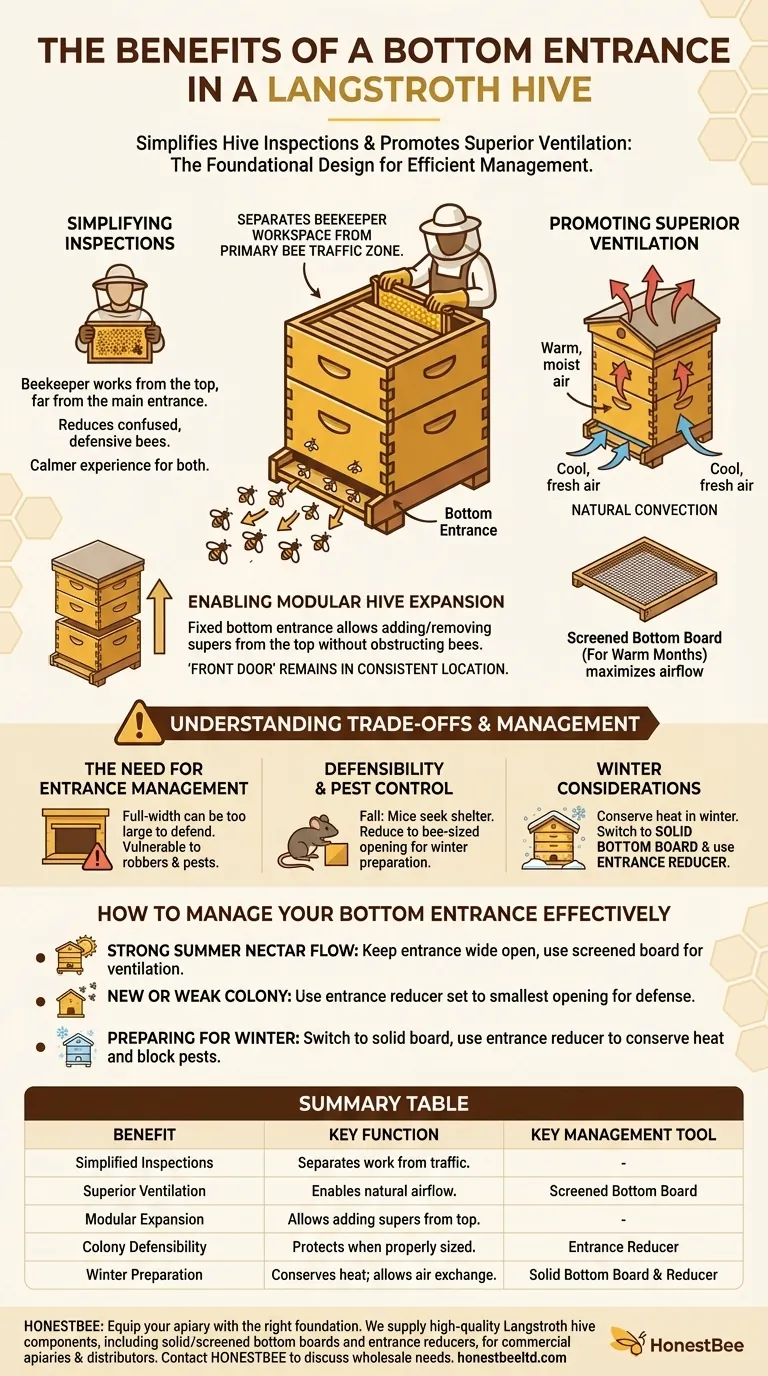At its core, a bottom entrance in a Langstroth hive provides two fundamental advantages: it simplifies hive inspections for the beekeeper and promotes superior ventilation for the colony. This design separates the beekeeper's workspace at the top of the hive from the bees' primary traffic zone at the bottom, creating a more manageable and healthy environment.
The bottom entrance is not merely a feature; it is a foundational design choice that enables the Langstroth hive's signature modularity. It establishes a predictable system that separates bee traffic from hive expansion, making management more efficient and less disruptive.

The Strategic Advantage of a Ground-Floor Entrance
The location of the entrance may seem like a minor detail, but it has profound implications for how you interact with the hive and how the colony functions. It is a key element that underpins the entire Langstroth system.
Simplifying Hive Inspections
When you open a hive from the top to inspect frames, you are intentionally working far away from the main entrance.
Foraging bees continue their flight patterns at the bottom, largely unaware of your presence. This significantly reduces the number of confused, defensive bees flying around your head, leading to a calmer experience for both you and the colony.
Promoting Superior Hive Ventilation
A bottom entrance is critical for airflow, which is essential for regulating temperature and humidity. It allows for natural convection: warm, moist air rises and can escape through the top, while cooler, fresh air is drawn in from below.
During warm months, a screened bottom board can be used in place of a solid one to maximize this effect, helping the bees cool the hive and dehydrate nectar into honey more efficiently.
Enabling Modular Hive Expansion
The fixed bottom entrance is the key to the Langstroth hive's modularity. Because the entrance is at the base, you can add or remove supers (honey boxes) from the top without ever obstructing the bees' path.
This design allows the colony's living and storage space to expand vertically, almost indefinitely, while the "front door" remains in a consistent, predictable location.
Understanding the Trade-offs and Management
While advantageous, a static bottom entrance is not a "set and forget" feature. Its size requires active management throughout the year to ensure the colony's security and health.
The Need for Entrance Management
A full-width opening can be too large for a small or developing colony to defend. It creates a vulnerability that can be exploited by robbing bees from stronger hives or by pests.
This is why beekeepers use an entrance reducer—a simple wooden block with different-sized notches—to adjust the opening to a size the colony can effectively guard.
Defensibility and Pest Control
In the fall, as temperatures drop, mice may try to seek shelter inside the warm hive. A wide-open bottom entrance is an open invitation.
Reducing the entrance to a smaller, bee-sized opening is a critical step in winter preparation to keep rodents and other pests out.
Winter Considerations
While ventilation is vital in summer, conserving heat is the priority in winter. A large entrance allows too much cold air in, forcing the winter cluster of bees to expend more energy to stay warm.
Beekeepers typically switch to a solid bottom board and use an entrance reducer to create a very small opening. This retains heat while still allowing for minimal air exchange and for bees to exit on cleansing flights.
How to Manage Your Bottom Entrance Effectively
Your management of the entrance should change with the seasons and the strength of your colony. Adjusting its size is one of the most powerful and simple actions you can take to support your bees.
- If your primary focus is a strong summer nectar flow: Keep the entrance wide open and consider a screened bottom board to maximize ventilation and accommodate heavy bee traffic.
- If your primary focus is establishing a new or weak colony: Use an entrance reducer set to its smallest opening to make the entrance easily defensible against robbers.
- If your primary focus is preparing for winter: Switch to a solid bottom board and use an entrance reducer to block mice and conserve the colony's precious heat.
Properly managing the bottom entrance is a key lever you can pull to directly influence your hive's health, security, and productivity.
Summary Table:
| Benefit | Key Function | Key Management Tool |
|---|---|---|
| Simplified Inspections | Separates beekeeper work from bee traffic, reducing defensiveness. | - |
| Superior Ventilation | Enables natural airflow for temperature/humidity control. | Screened Bottom Board |
| Modular Expansion | Allows adding supers from the top without blocking the entrance. | - |
| Colony Defensibility | Protects against robbing and pests when properly sized. | Entrance Reducer |
| Winter Preparation | Conserves heat while allowing for necessary air exchange. | Solid Bottom Board & Reducer |
Equip your apiary with the right foundation for success. Properly managing your hive's entrance is crucial for colony health and productivity. At HONESTBEE, we supply commercial apiaries and beekeeping equipment distributors with high-quality, durable Langstroth hive components, including solid and screened bottom boards and entrance reducers, through our wholesale-focused operations. Let us help you build a stronger, more manageable operation. Contact HONESTBEE today to discuss your wholesale needs!
Visual Guide

Related Products
- Multi-Functional Sliding Hive Entrance for Beekeeping
- Beehive Entrance Reducer Guardian Metal Hive Entrance for Bees
- Australian Pine Wood Langstroth Screen Bottom Board for Wholesale
- Beehive Entrance Discs Plastic Bee Entrance Disc for Bee Hives
- HONESTBEE Professional Multi-Functional Hive Tool with Ergonomic Wood Handle
People Also Ask
- What is the purpose of placing an object in front of the hive entrance after a move? A Guide to Forced Reorientation
- How do bees manage debris with a small hive entrance? A Guide to Strategic Hive Management
- What are some alternative strategies to using entrance reducers? Empower Your Bees for Natural Hive Defense
- How does the sliding design of the entrance reducer benefit beekeepers? Achieve Ultimate Hive Control
- Why is a smaller entrance size beneficial for a beehive? Boost Hive Defense & Productivity



















